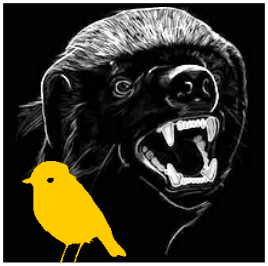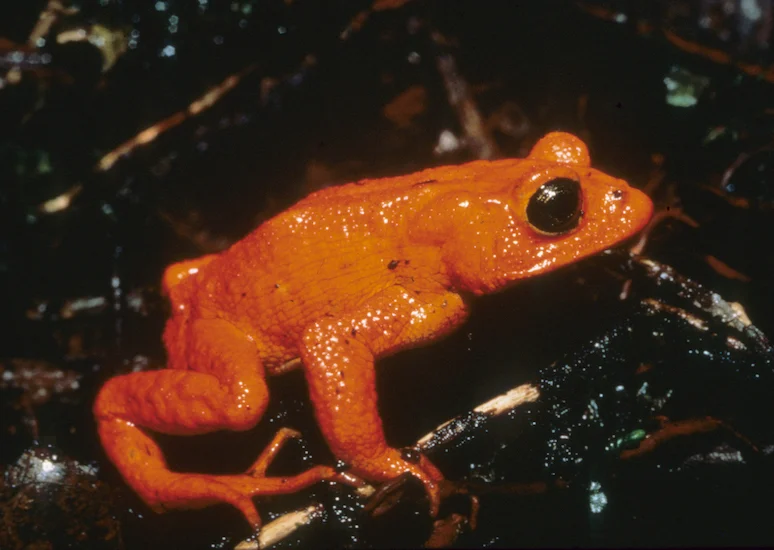Golden frog (Incilius periglenes) photo by Dr Marty Crump
Black eyes can be poisonous exclamations in orange frogs.

Prof. Mumblebard claims: “Most species of frogs have prominent eyes. Despite this, frogs avoid using their eyes for communication – with ocular social signalling being rare, and the staring down of would-be predators being unknown. Indeed, even conspicuous frogs with warning colouration obscure their eyes with longitudinal bands of pigment on the iris and facial skin. The only species of frogs known to use quasi-ocular signals are those that attempt to confuse predators by means of false eyespots on the hindquarters which draw attention away from the vulnerable head.”

Robin and the Honey Badger respond: “It’s true that most animals using garish colouration to warn predators of their toxicity tend to hide their eyes despite the extreme conspicuousness of their whole bodies. This certainly applies to frogs. However, various lineages of ‘toxic golden frogs’ are significant exceptions, with certain small species displaying an odd pattern of warning colouration: strikingly dark eyes that punctuate the uniformly orange skin. In all these independently evolved species, the eyes are darker than any other part of the body. Although the golden poison frog is the most frequently photographed example, a similar pattern of accentuation of the eyes can be seen in the granular poison frog, pumpkin toadlet, golden mantella, yellow harlequin frog and scarlet harlequin toad. In the case of the pumpkin toadlet, the small body may be easily overlooked despite its lurid colour, helping to explain the extraordinary anti-predator behaviours of this species, namely waving of the hands across the black eyes and alarm-vocalising even before being touched. The previously overlooked ocular displays in these four families and five genera of ‘toxic golden frogs’ differ from the false eyespots previously recorded in other frogs in that they send honest, not deceptive, messages to would-be predators. Furthermore, a converse pattern of colouration has arisen in several families of sexually dimorphic frogs. In these species, one sex turns vivid orange during the breeding season while the other sex remains camouflaged. What is revealing in the conspicuous sex is that the eye is not particularly accentuated, because the main function of self-advertisement is sexual attraction rather than the repulsion of potential predators. In summary, what has not been fully appreciated by biologists is that sexually monomorphic ‘toxic golden frogs’ are exceptional among frogs – with a colouration pattern that has evolved repeatedly – in displaying their real eyes to intimidate predators.”
Please join us here at the Bio-edge with your own comments. In the discussion below we encourage links to any evidence supporting either Prof. Mumblebard or Robin and the Honey Badger. Illustrations are welcome but please cite all sources or we may be forced under copyright to delete your comment

